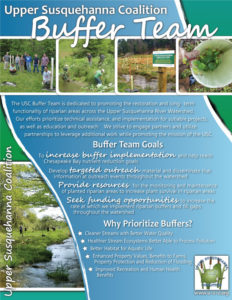USC Buffer Team
The goal of the USC Buffer Team is to promote the restoration and long-term functionality of riparian areas for water and habitat quality. These goals are achieved through innovative programming. The team is dedicated to ensuring practice functionality through education, outreach, and technical assistance.
Data collection to better understand buffer functionality is also a priority as is proving technical support of buffer issues to USC members. We strive to engage partners and utilize partnerships to leverage additional work to promote the mission of the USC.
2025 Buffer Team Goals
- Continue to engage with partners and contractors regarding buffer stewardship.
- Prioritize riparian restoration in areas where there are long term protections and easements.
- Advocate for support for SWCDs in their technical capacity and knowledge of reforestation planning and implementation.
- Secure native stock for Trees for Tributaries.
Targeted 2025 Projects
Our goals are to sustain and bolster the buffer steward program with the intent of getting more maintenance done on newer projects. We’d like to obtain larger stock for projects so we can get some visible shade on streams faster. Since there are some new faces, we’re hoping to collaborate with partners on trainings for new and existing buffer team staff. Look out for Water Quality Symposium forestry track courses, a Plant Materials Center training in May, and the Pennsylvania Buffer Summit in June. Lastly, we are going to continue building staff capacity throughout the watershed.
Buffer Team Events
Buffer Team News
Spotlighting Great Projects Across the Watershed: Delaware County Buffer Plantings
Delaware County SWCD Planting Projects The Susquehanna Program of the Delaware County Soil and Water Conservation District
Calling all Trees for Tributaries Projects!
We're searching for 2020 buffer projects in need of planting materials By: Lydia Brinkley USC Buffer Coordinator
Welcome USC Riparian Buffer Stewards
The USC Riparian Buffer Establishment Program kicked off June 6th with the Buffer Steward Training. The 6 stewards
Cover Photo: Chesapeake Bay Program





